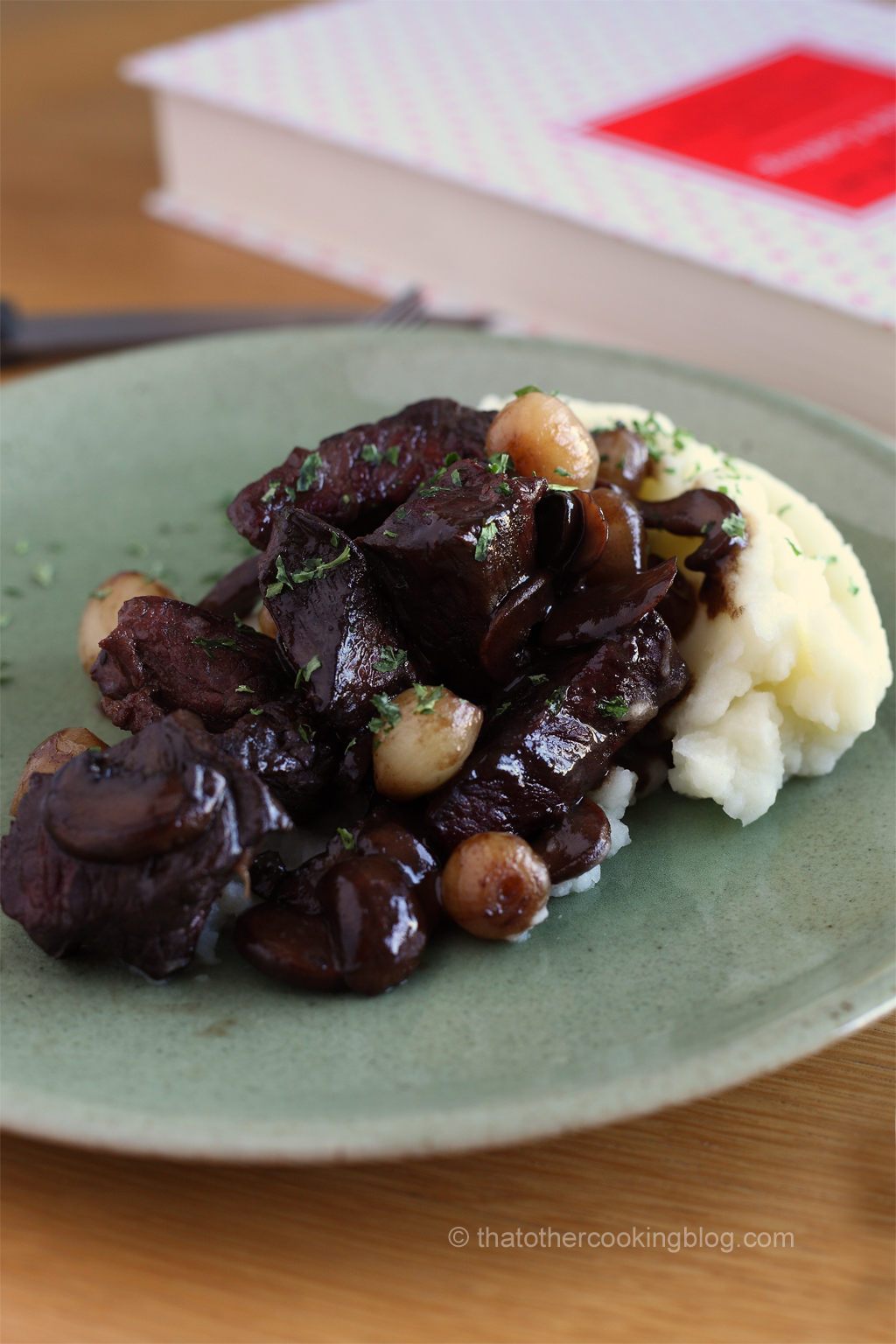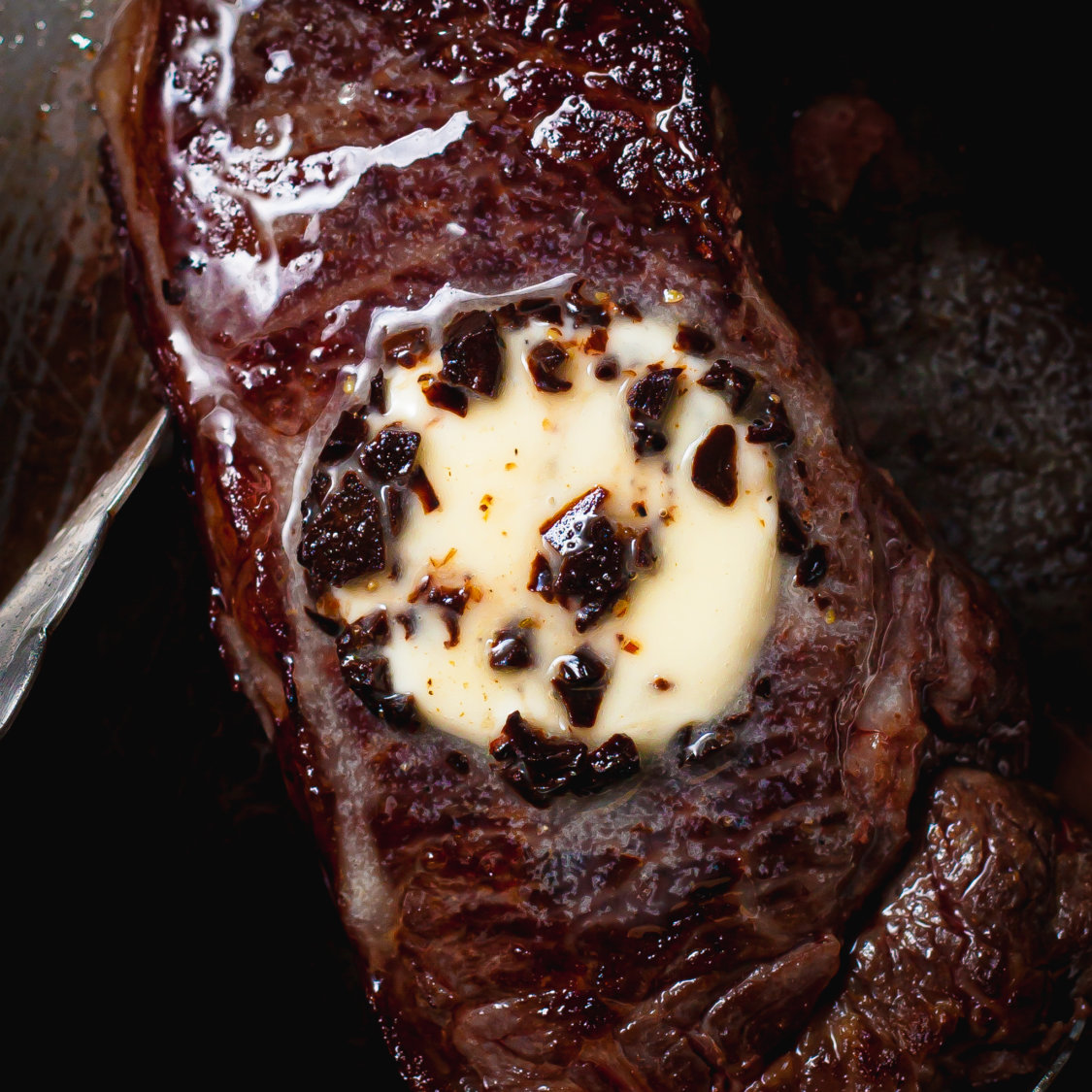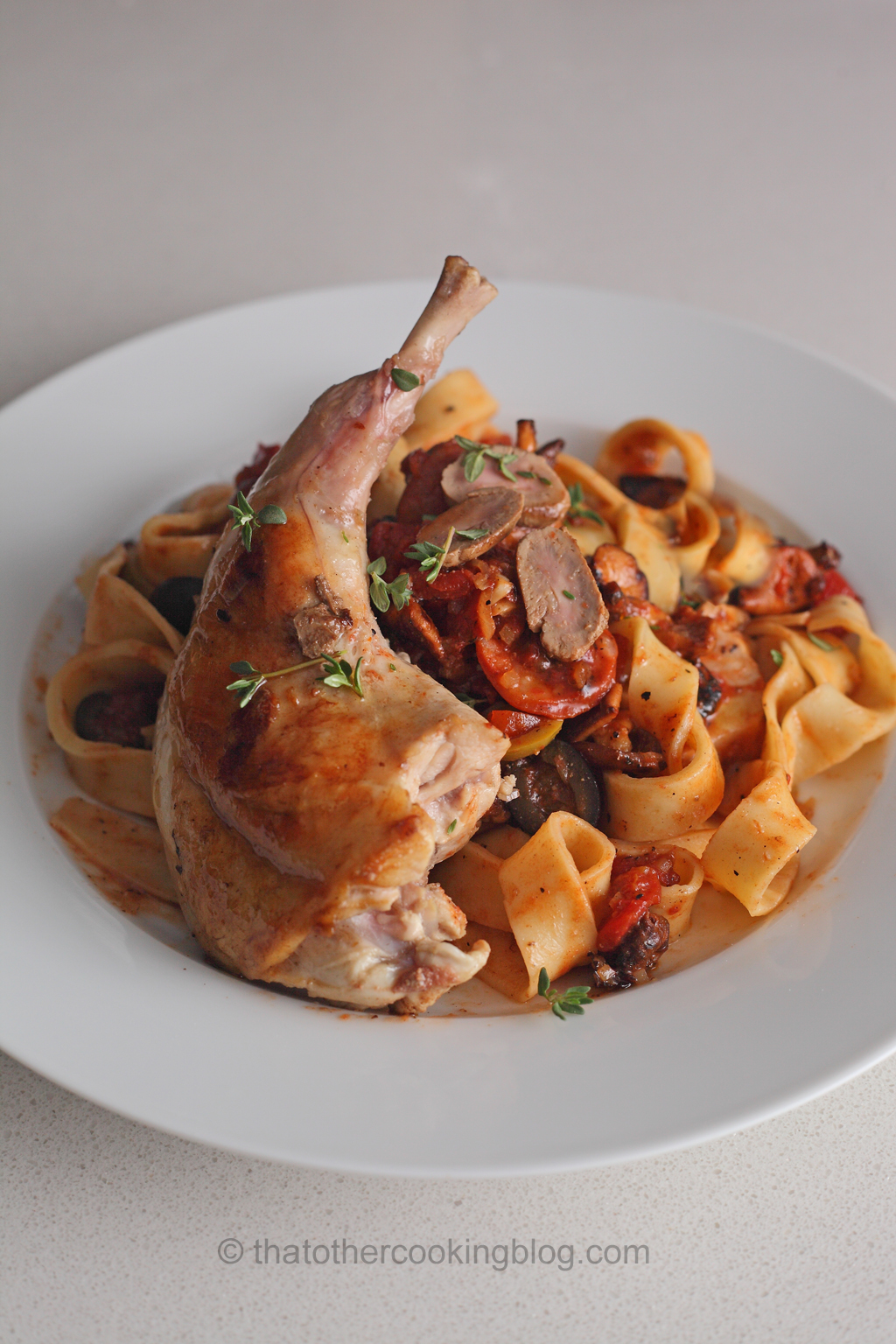I’ve posted about beef bourguignon in the past, but for the last couple of weeks I’ve been thinking of trying a different approach. Since this sous vide-meat kick doesn’t seem to end, I figured I’d try something fun. Making it sous vide. I was curious to see how this would turn out. I had to rearrange the order in which things are done (traditionally) in order to incorporate the technique, but I think I have a fairly easy procedure that allows making adjustments easily and control the final result without stress.

Also, the meat can be cooked to medium or medium rare, which is unusual for any traditional stew in which the cooking temperatures for the meat can reach the boiling point. Even the temperatures in slow cookers at the warm setting cook at over 70C which is technically well done. In this example, the meat is cooked to medium at a gentle 60C for 24 hours.
Ingredients (4 servings):
Beef Stew:
2 lb beef for stew
1/4 small cubed bacon
1 bottle of nice burgundy wine
20 pearl onions
1 lb coarsely chopped mushrooms
1 white onion, small dice
2 carrots, small dice
2 celery stalks, small dice
2 mashed garlic cloves
1 bay leaf
sugar, salt and pepper to taste
1 rosemary sprig
about 1/2 Tbsp AP flour
Parsley for garnishing.
Mashed Potatoes:
2 Russet potatoes
3 Tbsp heavy cream
Salt to taste
Pre-searing the meat. This is a key step in stewing meats. Develops flavor as the meat browns. Make sure the beef cubes are dry before heating the searing hot pan or not only oil and water will splatter all over the plate, but there’s a big chance that the meat ends up boiling in the pan rather than browning. Flouring the meat cubes before searing them is another approach to develop nice browning and keeps the cubes drier for a bit longer, this flour will eventually help thicken the sauce as well. I chose to skip this and sear the meat conventionally. So, on a cast iron or stainless steel wide pan, add enough vegetable oil to cover the bottom by 1mm. Add the bacon cubes and allow them to render their fat and start browning. Allow the oil to get really hot but don’t burn it. Add the meat in batches if you fear the pan isn’t wide enough and might get too crowded in there. Once seared, reserve the meat and the bacon cubes in a container. Reserve the cooking fat. Deglaze the pan with some wine or water. Scrape the brown bits off. Reduce until syrupy, remove pan from the stove and Allow meat glaze to cool before adding it to the sous vide bag. Notice I didn’t salt the meat. I was trying to work fast. Salt will draw some moisture out, which will mess with the searing step. If you have enough time, about 1/2 to 1 hour. You could salt the meat and dry it with paper towels before searing. I chose to season later. It’s going to cook for 24 hours with plenty of seasoning anyways.
Browning the mushrooms. In the same pan, about 1/2 Tbsp of butter over medium high heat. When the butter stops bubbling is time to get the mushrooms in there. Brown mushrooms for about 5 minutes. Cover the pan, cook for another minute or two. Reserve mushrooms. Deglaze as well. With some wine or water. Don’t discard the butter. Who discards butter? Reduce, and reserve this glaze as well.
Browning the pearl onions. Follow the same procedure for the mushrooms. Cooking mushrooms and onions together is also an options. Make sure the pan doesn’t get too crowded though. Deglaze and reserve this glaze as well. All these glazes can be store in one jar.
The wine reduction. No wine reduction, no beef bourguignon. I used the same pan again. Remember that bacon fat we render in the first step. Add it back to the pan. Over medium high heat, add the chopped onions, celery and carrots. Sweat for about 7-10 minutes. Now I started adding salt. Add 750ml of your favorite burgundy here. Yeah, the whole bottle. Add the glaze from the meat, bacon, mushrooms and pearl onions into the pan. Garlic and the bay leaf. Reduce. I also added the browned bacon bits to the reduction to extract all their flavor which would be hard to do at 60C. This could take a while, be patient. And by a while I mean, about 30 minutes or until the carrots are super soft. Add water if the reduction is going to fast and the vegetables haven’t had time to release all their potential. Some might want to add some tomato paste, fish sauce… all great additions, I didn’t. Strain the wine reduction (fine strainer like a chinois) Remember to scrape the bottom of your strainer and get as much sauce as possible. Return strained sauce to the pan and bring to a simmer. Dissolve the flour into about a Tbsp of cold water. Add to the reduction. Allow to cook for a few minutes. Now the sauce should be fairly thick. Thicker than it will be in the final dish but that’s ok. During the 24 hour in the bag. The meat will release water and thin the sauce again. As this reduction cooks, keep tasting and adjusting. I keep good white wine vinegar and sugar at hand, along with salt and pepper. Once you’re happy with the reduction. Allow to cool.
The sous vide step. The simplest step actually. Setup your water bath to 60C. Add the wine reduction, beef cubes, mushrooms, pearl onions, and the rosemary sprig into the bag. Adjust seasoning. Vacuum seal, or remove the air using the water displacement method. Add the bag to the water bath and cook for 24 hours.
Making the mashed potatoes. Peel and cube the potatoes. I usually cook potatoes whole with the skin on. But russets are very starchy and tend to make the potato mash gooey. Not a good texture. Peeled and cubed potatoes release more of their starch into the cooking water, which you could discard. I reserve a bit of the water though. Has good potato flavor. Once the potatoes are soft, about 10 minutes. Strain, return to the pot. Turn the heat off. Add the heavy cream. I also added some butter. Nobody said this was gonna be a light meal. If you have a potato ricer, use it. I don’t have one. I don’t have a masher either. I used my fine strainer and worked the potatoes through it using a silicon spatula. It was a lot of work but possibly the best mashed potatoes I’ve made here at thatothercookingblog.com. Adjust The seasoning. I only add salt.
After sous vide. Remove the meat, onions and mushrooms form the bag. Discard the rosemary sprig. If the sauce is too thin. Return it to a wide pan and quickly reduce it until syrupy again. Check for seasoning. This should take about 10 minutes. Remove pan from the heat and add the meat. Allow to cool. The sauce should coat the meat nicely. The stew can be cooked in advanced and kept in the fridge for a week, in the sealed bag. The flavor would develop during that time. Or you can devour it right away which is what usually happens here.
A few thoughts. Another advantage of cooking this using an immersion circulator (or a water bath) is flavor. Since no aroma is released during the cooking time, the flavor intensity is incredible. Also, make it impossible overcooking the pearl onions and the mushrooms. Those stay cooked al dente. It’s really wonderful to have this amount of control. A few things could be improved though. I would like to try a 36h cooking time, or a fattier cut of meat. If the meat is too lean, it will release more liquid over long periods of cooking time. Fattier meat could work better with the sous vide approach. I would also like to have more liquid in the final sauce. The yield wasn’t good enough. I could have used more flour to thicken it, and increase the yield this way, but that would decrease the flavor intensity. Not an option. I might need to add stock or demi-glace. Adding extra butter would also help. Everybody knows that when in doubt, add more butter. Until the next one!

Wanna get more sous-vide cooking guides and cool cooking how-to’s in your mailbox? You know what needs to be done!
We never spam. You should only be getting updates when new content is posted on the site. We also respect your privacy. We don’t share your email address with anyone and you can unsubscribe anytime!





14 comments
It’s an interesting approach, the colour and shine does look different, but it does look good. I have made goef bourguignon before, and ok maybe because I’ve only made it once, I’m not brave enough to steer myself from my original recipe, so a big nod to you for making this innovative version of it! I hope you’re having a lovely weekend 🙂
Hi Sofia! I reposted the pics with a new white balance… I’m still fighting this lighting situation, hopefully it looks a little better, but yes, the color is very deep. I hope you have a lovely weekend too! Thanks for stopping by! Are you gonna try en sous vide cooking soon?? 🙂
What a hearty dish, Paul. I am always so intrigued by your sous vide recipes!
thanks Patty! you should try if you haven’t 🙂
I have not! But one day I shall. 😀
The first time I tried I bought frozen fish, don’t tell gordon ramsey… and had a thermometer, I placed the fish still in its vacuumed sealed pouch in a wide tray, like a hotel pan, and filled it with hot tap water, the tap water in my building was hot enough to cook the fish sous vide. Actually, I just four this awesome link 🙂
http://modernistcuisine.com/recipes/sous-vide-salmon-in-the-kitchen-sink/
That’s crazy! I’m checking out the link right now and that salmon looks amaaazing!
I dont understand a lot of the word here, but the pic is beautiful! Wish I had gotten to have some 🙂
how come, its your first language! the problem is that it isn’t mine 🙂 thanks lotis!
I love my sous vide. I’m a bit old fashioned to try it with such a traditional recipe like this, but why not?!!! It obviously worked beautifully!
Thanks Mimi! I really like making beef stews the old fashion way too, but I was feeling a bit adventurous the other day 🙂
it looks delicious and worth the time! how do you do your sous vide? what are you using?
Ah thank you! Glad you liked it 🙂 I have an immersion circulator, a polyscience one. I use the pot from my pressure cooker and place the immersion in it. You can use any container that won’t rust or melt 🙂 It’s pretty easy. I bought the IC on ebay. Let me know if you have more questions please, I love talking about this stuff haaha. Oh, and I have a vacuum chamber but it’s in storage now, so I’be been using ziplock baggies and get the air out of the bag via water displacement.
relinking